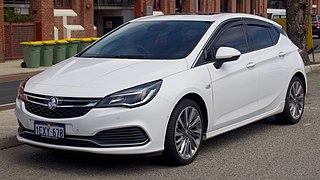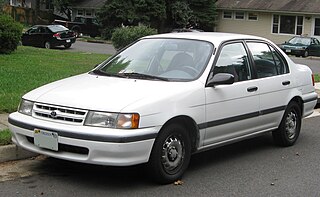
The Ford Laser is a compact car, originally a subcompact car in the first three generations, which was sold by Ford in Asia, Oceania, and parts of South America, and Africa. It has generally been available as a sedan or hatchback, although convertible, wagon and pick-up versions have also been available in different markets. The sedan, and briefly station wagon, versions were badged Ford Meteor in Australia between 1981 and 1987. The Ford Meteor name was also used in South Africa.

The Holden Astra is a small car formerly marketed by Holden. The first couple of generations of Astra were made only for Australia, and was a derivative of the locally produced Nissan Pulsar. With the Button car plan coming into effect, it was succeeded by the Holden Nova swiftly.

The Opel Vectra is a large family car that was engineered and produced by the German automaker Opel. In the United Kingdom, the car was sold under the Vauxhall marque as the Vauxhall Cavalier and later as the Vauxhall Vectra, from 1995 onwards. It has also been sold by Holden in Australasia as the Holden Vectra, and by Chevrolet in Latin America as the Chevrolet Vectra.

The BMW 3 Series is a compact executive car manufactured by the German automaker BMW since May 1975. It is the successor to the 02 Series and has been produced in seven different generations.

The Ford Ikon is a subcompact car produced by Ford since the end of 1999. It has been initially introduced as the sedan version of the Ford Fiesta hatchback car. It spawned over two generations, the first being based on the fourth generation of the Ford Fiesta and bearing a similar front end design.

The Chevrolet Aveo (T200) is the first generation of the Chevrolet Aveo, a subcompact automobile from the Chevrolet division of the American manufacturer General Motors, launched in 2002, developed by the initially independent South Korean manufacturer Daewoo, later GM Korea. It was originally marketed as the Daewoo Kalos and prominently marketed as the Aveo. The model received the T200 internal codes during the car's development. The T250 code was designated for the model's facelift.

The Nissan Sunny is an automobile built by the Japanese automaker Nissan from 1966 to 2006. In the early 1980s, the brand changed from Datsun to Nissan in line with other models by the company. Although production of the Sunny in Japan ended in 2006, the name remains in use in the Chinese market for a rebadged version of the Nissan Latio.

The Suzuki Swift is a subcompact car produced by Suzuki. The Suzuki Swift is classified in B-segment in European single market, segment known as Supermini in British islands. Prior to this, the "Swift" nameplate had been applied to the Suzuki Cultus in numerous export markets.

The Mazda 3 is a compact car manufactured in Japan by Mazda. It was introduced in 2003 as a 2004 model, replacing the Familia/323/Protegé in the C-segment. A performance-oriented version of the Mazda3 was marketed as the Mazdaspeed3 in North America, Axela in Japan, and the Mazda 3 MPS in Europe.

The Daihatsu Charade is a supermini car produced by the Japanese manufacturer Daihatsu from 1977 to 2000. It is considered by Daihatsu as a "large compact" car, to differentiate it from the smaller kei car compacts in its line-up, such as the Daihatsu Mira. In Japan, it offers buyers more interior space and a larger engine that is more appreciated with regards to Japanese driving conditions and speed limits in Japan realistically not exceeding 40 km/h (24.9 mph) in urban areas. It replaced the Daihatsu Consorte, although the Charmant took over from the bigger-engined Consortes.

The Mitsubishi Mirage is a range of cars produced by the Japanese manufacturer Mitsubishi from 1978 to 2003 and again since 2012. The hatchback models produced between 1978 and 2003 were classified as subcompact cars, while the sedan and station wagon models, marketed prominently as the Mitsubishi Lancer, were the compact offerings. The liftback introduced in 1988 complemented the sedan as an additional compact offering, and the coupé of 1991 fitted in with the subcompact range. The current Mirage model is a subcompact hatchback and sedan and it replaces the Mitsubishi Colt sold between 2002 and 2012.

The Nissan Tiida is a compact car produced by the Japanese manufacturer Nissan since 2004, spanning two generations.

The Kia Rio is a subcompact car produced by the South Korean manufacturer Kia Motors since November 1999 and now in its fourth generation. Body styles have included a three and five-door hatchback and four-door sedan, equipped with inline-four gasoline and diesel engines, and front-wheel drive.

The Hyundai Accent, or Hyundai Verna in South Korea, is a subcompact car produced by Hyundai. In Australia, the first generation models carried over the Hyundai Excel name used by the Accent's predecessor. The Accent was replaced in 2000 by the Hyundai Verna in South Korea, although most international markets, including the US, retained the "Accent" name.

The Toyota Tercel is a subcompact car manufactured by Toyota from 1978 to 1999 across five generations, in five body configurations sized between the Corolla and the Starlet. Manufactured at the Takaoka plant in Toyota City, Japan, and sharing its platform with the Cynos and the Starlet, the Tercel was marketed variously as the Toyota Corolla II — sold at Toyota Japanese dealerships called Toyota Corolla Stores — and was replaced by the Toyota Platz in 1999. It was also known as the Toyota Corsa and sold at Toyopet Store locations. Starting with the second generation, the Tercel dealership network was changed to Toyota Vista Stores, as its badge engineered sibling, the Corolla II, was exclusive to Toyota Corolla Store locations.
Tianjin FAW is an automobile company based in Tianjin, China and a subsidiary of FAW Group. Its principal activity is the design, development, manufacture and distribution of automobiles sold under the Xiali and Vita marques. It is listed on the Shenzhen Stock Exchange.

The Suzuki SX4 is a compact car and crossover developed jointly by Japanese automaker Suzuki and Italian automaker Fiat, sold since 2006. It was available as a hatchback and sedan, with the former available in both front and four wheel drive. In 2013, the second generation was launched, called Suzuki SX4 S-Cross — now exclusively a mini SUV, with a sedan version no longer offered. The first and second generation SX4s sold alongside one another until 2014. The second generation SX4 has not been marketed as a Fiat, and the SX4 sedan was replaced with the Suzuki Ciaz.

The Geely HQ is a station wagon from Chinese manufacturer, Geely Automobile. It was the first Geely product, introduced in February 1998. Originally a 993 cc Daihatsu three cylinder or a 1,342 cc Toyota inline four were offered, with 52 PS (38 kW) or 86 PS (63 kW) respectively. A 5-door hatchback is also available known as the "Liangjing."

The Nissan Sylphy is a compact car, produced by the Japanese car maker Nissan, as the successor to the Nissan Pulsar. Built since 2000 and currently in its third generation, the second generation is still manufactured for certain markets. Sylphy has also been marketed in export markets under several other model names, including Pulsar and Sentra.

The Mercedes-Benz C-Class (W203) is an automobile which was produced by German manufacturer Mercedes-Benz from July 2000 to December 2006. It was the second iteration in the Mercedes-Benz C-Class line up.




















